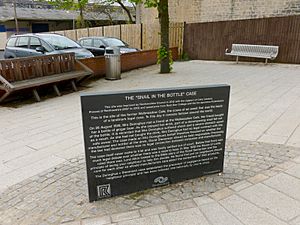Donoghue v Stevenson facts for kids
Quick facts for kids Donoghue v Stevenson |
|
|---|---|
 |
|
| Court | House of Lords |
| Full case name | M'Alister (or Donoghue) (Pauper) v Stevenson |
| Decided | 26 May 1932 |
| Citation(s) |
|
| Transcript(s) | House of Lords transcript |
| Case history | |
| Prior action(s) | Outer House of the Court of Session ([1930] SN 117) |
| Appealed from | Inner House of the Court of Session ([1930] SN 138) |
| Case opinions | |
| Manufacturers have a legal duty of care to the ultimate consumers of their products if it is not possible for defects to be identified before the goods are received. | |
| Court membership | |
| Judges sitting |
|
| Keywords | |
|
|
Donoghue v Stevenson is a very important court case from 1932. It is often called the "Paisley Snail" or "Snail in the Bottle" case. This case changed the law of negligence (carelessness) in many countries. It helped create the idea that people and companies have a "duty of care" towards others. This means they must act carefully to avoid harming others.
The case was about Mrs. May Donoghue, who found a decomposed snail in her bottle of ginger beer. She got sick and decided to sue the company that made the drink, Mr. Stevenson. The highest court in the UK at the time, the House of Lords, decided that the manufacturer (Mr. Stevenson) did owe Mrs. Donoghue a duty of care. This was a big deal because, before this case, it was very hard to sue a manufacturer if you didn't buy the product directly from them.
Contents
The Snail in the Bottle: What Happened?
On a Sunday evening in August 1928, May Donoghue went to a café in Paisley, Renfrewshire, Scotland. She was with a friend. Her friend ordered an ice cream float for Mrs. Donoghue. This drink was made with ice cream and ginger beer. The ginger beer came in a dark, opaque bottle. This meant you couldn't see inside it.
Mrs. Donoghue drank some of her float. But when her friend poured the rest of the ginger beer into the glass, a decomposed snail floated out of the bottle! Mrs. Donoghue said she felt very ill from seeing this. She later complained of stomach pain and had to see a doctor. She was even admitted to the hospital for treatment. Doctors said she had severe stomach problems and shock.
The ginger beer was made by David Stevenson's company in Paisley. Mrs. Donoghue's friend wrote down the company's details from the bottle.
Why Mrs. Donoghue Sued
Mrs. Donoghue decided to sue Mr. Stevenson for £500. This was a lot of money back then. She claimed that Stevenson's company had a duty to make sure snails didn't get into their ginger beer bottles. She said they failed to clean the bottles properly. She believed this carelessness caused her to get sick.
Mr. Stevenson, the manufacturer, argued that his bottles didn't have snails. He also said that if Mrs. Donoghue was sick, it was because of her own health, not his ginger beer.
The Legal Problem Before This Case
Before Donoghue v Stevenson, if you were hurt by a faulty product, you usually had to prove you had a contract with the seller. But Mrs. Donoghue didn't buy the ginger beer herself; her friend did. And neither of them had a contract directly with Mr. Stevenson, the manufacturer. So, Mrs. Donoghue had to sue for "negligence" (carelessness).
At that time, there wasn't a general rule that manufacturers had to be careful with their products for everyone who might use them. There were only a few special cases where a "duty of care" existed. For example, if a product was naturally dangerous (like explosives) or if the maker intentionally hid a danger. Ginger beer wasn't seen as naturally dangerous, and Stevenson didn't hide anything on purpose.
A similar case, Mullen v AG Barr & Co Ltd, had just happened. In that case, children found dead mice in ginger beer bottles. The court said the manufacturer wasn't responsible because there was no contract with the consumers. This made Mrs. Donoghue's case very difficult.
The Court Decisions
Mrs. Donoghue's case went through several courts.
The First Court (Outer House)
The first judge, Lord Moncrieff, heard the case in June 1930. He believed that people who make food or drinks should be held responsible if their products are not clean and cause harm. He said that "tainted food" is very dangerous. He thought it didn't matter if the danger was caused by carelessness and wasn't obvious. He ruled that Mrs. Donoghue's claim could go forward.
The Next Court (Inner House)
Mr. Stevenson appealed this decision to a higher court, the Inner House. The judges there had also heard the Mullen case (about the mice in ginger beer). They mostly agreed with their earlier decision in Mullen. They said that the only difference was a snail instead of a mouse. So, they decided that Mr. Stevenson did not owe Mrs. Donoghue a duty of care.
The Highest Court (House of Lords)
Mrs. Donoghue then took her case to the highest court, the House of Lords. She was allowed to pursue the case "in forma pauperis," meaning she was very poor and didn't have to pay court fees if she lost. Her lawyers worked for free.
The appeal was heard in December 1931 by five senior judges, called Law Lords. Mrs. Donoghue's lawyers argued that manufacturers should be careful when making products that are sealed and meant for people to eat or drink. They said that because the ginger beer bottle was dark and sealed, Mrs. Donoghue couldn't check it herself.
Mr. Stevenson's lawyers argued that there was no existing law that said a manufacturer had a duty to someone they didn't have a contract with.
The House of Lords gave its decision on May 26, 1932. After a long wait, they decided, by a vote of 3 to 2, that Mrs. Donoghue's case was valid. This meant she had a right to sue.
Lord Atkin's "Neighbour Principle"
The most important part of the decision came from Lord Atkin. He said that the law should reflect common sense and morality. He introduced his famous "neighbour principle."
You must take reasonable care to avoid acts or omissions which you can reasonably foresee would be likely to injure your neighbour. Who, then, in law, is my neighbour? The answer seems to be – persons who are so closely and directly affected by my act that I ought reasonably to have them in contemplation as being so affected when I am directing my mind to the acts or omissions which are called in question.
In simple terms, this means:
- You must be careful not to hurt people.
- Your "neighbour" in law is anyone who you can reasonably expect to be affected by your actions.
- If you make a product, you should think about the people who will use it. If you are careless, and they get hurt because they couldn't check the product, then you might be responsible.
Lord Atkin believed it would be a "grave defect" in the law if someone couldn't get help after being harmed by carelessly made food. He said that manufacturers of everyday items like food, medicine, or soap should owe a duty of care to their customers.
The Other Judges
Lord Thankerton and Lord Macmillan agreed with Lord Atkin. Lord Thankerton said that if a product is sealed and can't be checked, the manufacturer has a direct relationship with the consumer. Lord Macmillan said that the law of negligence must adapt to new situations. He found that Stevenson was careless and owed Mrs. Donoghue a duty of care.
Two judges, Lord Buckmaster and Lord Tomlin, disagreed. They thought the court should only follow old rules and not create new ones. Lord Buckmaster said that if the law went beyond contracts, there would be no end to who could sue. Lord Tomlin worried that Lord Atkin's idea would open the door to too many lawsuits.
What Happened After the Judgment?
After the House of Lords decision, the case was sent back to a lower court to decide the facts. Mrs. Donoghue still had to prove that there was a snail and that Stevenson's carelessness caused her illness. However, Mr. Stevenson died in November 1932.
The case was eventually settled out of court in December 1934. Mrs. Donoghue received £200, which was less than she originally asked for, but still a significant amount.
Mrs. Donoghue continued to work as a shop assistant. She died in 1958 at the age of 59. Mr. Stevenson's business was taken over by his family and later sold. The café where the snail was found closed down and was demolished years later.
Why This Case is So Important
Donoghue v Stevenson is a landmark case because it created the modern law of negligence. Lord Atkin's "neighbour principle" became the foundation for deciding when someone owes a "duty of care" to another person. This means that if you act carelessly and it causes harm to someone you should have thought about, you might be legally responsible.
How the "Neighbour Principle" Grew
The idea of the "neighbour principle" wasn't entirely new. An earlier judge, Lord Esher, had suggested a similar idea in a case called Heaven v Pender. He said that if you are in a situation where your actions could hurt someone, you have a duty to be careful.
Two American cases also influenced this idea. In Thomas v Winchester, a pharmacist mislabeled poison, causing someone to get very sick. The court said the pharmacist was responsible because his actions created a direct danger. In MacPherson v Buick Motor Co., a car wheel broke, injuring the driver. The court said the car manufacturer could be responsible even without a contract.
Over time, the "neighbour principle" from Donoghue v Stevenson was used in more and more situations.
- In the 1963 case of Hedley Byrne v Heller, the court said that if someone gives careless advice, they might also owe a duty of care, even if there's no contract.
- In the 1970 case of Home Office v Dorset Yacht Co, the court said that the "neighbour principle" should apply in almost all situations unless there's a good reason not to. This case involved young offenders escaping from a borstal and damaging a yacht. The court found the Home Office owed a duty of care.
How Duty of Care is Decided Now
Today, courts use a three-part test (called the Caparo test) to decide if a duty of care exists:
- Can you reasonably foresee that your actions might cause damage?
- Is there a close enough relationship between the people involved?
- Is it fair, just, and reasonable for the law to say there is a duty of care in this situation?
This case changed how the law works. It made it clear that manufacturers and others have a responsibility to be careful, even if they don't have a direct contract with the person who gets hurt.
Commemoration
In 1990, legal groups from Canada and Scotland held a special event in Paisley to remember the case. They unveiled a memorial at the spot where the Wellmeadow Café used to be. A bench was added later, and both were replaced in 2012.
In 1996, a documentary film called The Paisley Snail was made about the case.
Was There Really a Snail?
Some people have joked that there was never actually a snail in the bottle. A judge named Lord Justice MacKinnon once said that it was proven there was no snail. However, he was mistaken. The case was settled out of court because Mr. Stevenson died. This means the facts of what happened in the café were never actually proven in court. So, we will probably never know for sure if the snail was really there!







